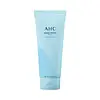What's inside
What's inside
 Key Ingredients
Key Ingredients

 Benefits
Benefits

 Concerns
Concerns

 Ingredients Side-by-side
Ingredients Side-by-side

Water
Skin ConditioningSodium Cocoyl Isethionate
CleansingGlycerin
HumectantHydroxypropyl Starch Phosphate
Sodium Methyl Cocoyl Taurate
CleansingDecyl Glucoside
CleansingPotassium Cocoyl Glycinate
Cetearyl Alcohol
EmollientGlyceryl Stearate
EmollientSorbitan Olivate
EmulsifyingGlycol Distearate
EmollientPotassium Cocoate
EmulsifyingCaprylyl Glycol
EmollientCitric Acid
BufferingPolyquaternium-67
Glyceryl Caprylate
EmollientDisodium EDTA
Sodium Acetate
BufferingSodium Chloride
MaskingPanthenol
Skin ConditioningPentylene Glycol
Skin ConditioningMadecassoside
AntioxidantWater, Sodium Cocoyl Isethionate, Glycerin, Hydroxypropyl Starch Phosphate, Sodium Methyl Cocoyl Taurate, Decyl Glucoside, Potassium Cocoyl Glycinate, Cetearyl Alcohol, Glyceryl Stearate, Sorbitan Olivate, Glycol Distearate, Potassium Cocoate, Caprylyl Glycol, Citric Acid, Polyquaternium-67, Glyceryl Caprylate, Disodium EDTA, Sodium Acetate, Sodium Chloride, Panthenol, Pentylene Glycol, Madecassoside
Water
Skin ConditioningGlycerin
HumectantPalmitic Acid
EmollientStearic Acid
CleansingMyristic Acid
CleansingPotassium Hydroxide
BufferingLauric Acid
CleansingCocamidopropyl Betaine
CleansingEnteromorpha Compressa Extract
Skin ProtectingCodium Tomentosum Extract
Skin ProtectingSodium Chloride
MaskingUndaria Pinnatifida Extract
Skin ConditioningParfum
MaskingButylene Glycol
HumectantSodium Benzoate
MaskingPotassium Sorbate
PreservativeAcrylates/C10-30 Alkyl Acrylate Crosspolymer
Emulsion StabilisingPEG-14m
Emulsion StabilisingArachidic Acid
CleansingCellulose Gum
Emulsion Stabilising1,2-Hexanediol
Skin ConditioningDisodium EDTA
Silica
AbrasiveCitrus Paradisi Fruit Extract
Skin ConditioningSaponaria Officinalis Leaf/Root Extract
Skin ConditioningMaris Aqua
HumectantCaprylic/Capric Triglyceride
MaskingHydrogenated Lecithin
EmulsifyingButyrospermum Parkii Butter
Skin ConditioningSodium Hyaluronate
HumectantCeramide NP
Skin ConditioningCeramide AP
Skin ConditioningCeramide Ns
Skin ConditioningCholesterol
EmollientCeramide As
Skin ConditioningEucalyptus Globulus Leaf Extract
PerfumingMadecassic Acid
Skin ConditioningPhytosphingosine
Skin ConditioningAsiatic Acid
Skin ConditioningAsiaticoside
AntioxidantCeramide EOP
Skin ConditioningWater, Glycerin, Palmitic Acid, Stearic Acid, Myristic Acid, Potassium Hydroxide, Lauric Acid, Cocamidopropyl Betaine, Enteromorpha Compressa Extract, Codium Tomentosum Extract, Sodium Chloride, Undaria Pinnatifida Extract, Parfum, Butylene Glycol, Sodium Benzoate, Potassium Sorbate, Acrylates/C10-30 Alkyl Acrylate Crosspolymer, PEG-14m, Arachidic Acid, Cellulose Gum, 1,2-Hexanediol, Disodium EDTA, Silica, Citrus Paradisi Fruit Extract, Saponaria Officinalis Leaf/Root Extract, Maris Aqua, Caprylic/Capric Triglyceride, Hydrogenated Lecithin, Butyrospermum Parkii Butter, Sodium Hyaluronate, Ceramide NP, Ceramide AP, Ceramide Ns, Cholesterol, Ceramide As, Eucalyptus Globulus Leaf Extract, Madecassic Acid, Phytosphingosine, Asiatic Acid, Asiaticoside, Ceramide EOP
 Reviews
Reviews

Ingredients Explained
These ingredients are found in both products.
Ingredients higher up in an ingredient list are typically present in a larger amount.
Disodium EDTA plays a role in making products more stable by aiding other preservatives.
It is a chelating agent, meaning it neutralizes metal ions that may be found in a product.
Disodium EDTA is a salt of edetic acid and is found to be safe in cosmetic ingredients.
Learn more about Disodium EDTAGlycerin is already naturally found in your skin. It helps moisturize and protect your skin.
A study from 2016 found glycerin to be more effective as a humectant than AHAs and hyaluronic acid.
As a humectant, it helps the skin stay hydrated by pulling moisture to your skin. The low molecular weight of glycerin allows it to pull moisture into the deeper layers of your skin.
Hydrated skin improves your skin barrier; Your skin barrier helps protect against irritants and bacteria.
Glycerin has also been found to have antimicrobial and antiviral properties. Due to these properties, glycerin is often used in wound and burn treatments.
In cosmetics, glycerin is usually derived from plants such as soybean or palm. However, it can also be sourced from animals, such as tallow or animal fat.
This ingredient is organic, colorless, odorless, and non-toxic.
Glycerin is the name for this ingredient in American English. British English uses Glycerol/Glycerine.
Learn more about GlycerinChances are, you eat sodium chloride every day. Sodium Chloride is also known as table salt.
This ingredient has many purposes in skincare: thickener, emulsifier, and exfoliator.
You'll most likely find this ingredient in cleansers where it is used to create a gel-like texture. As an emulsifier, it also prevents ingredients from separating.
There is much debate on whether this ingredient is comedogenic. The short answer - comedogenic ratings don't tell the whole story. Learn more about comegodenic ratings here.
The concensus about this ingredient causing acne seems to be divided. Research is needed to understand if this ingredient does cause acne.
Scrubs may use salt as the primary exfoliating ingredient.
Learn more about Sodium ChlorideWater. It's the most common cosmetic ingredient of all. You'll usually see it at the top of ingredient lists, meaning that it makes up the largest part of the product.
So why is it so popular? Water most often acts as a solvent - this means that it helps dissolve other ingredients into the formulation.
You'll also recognize water as that liquid we all need to stay alive. If you see this, drink a glass of water. Stay hydrated!
Learn more about Water